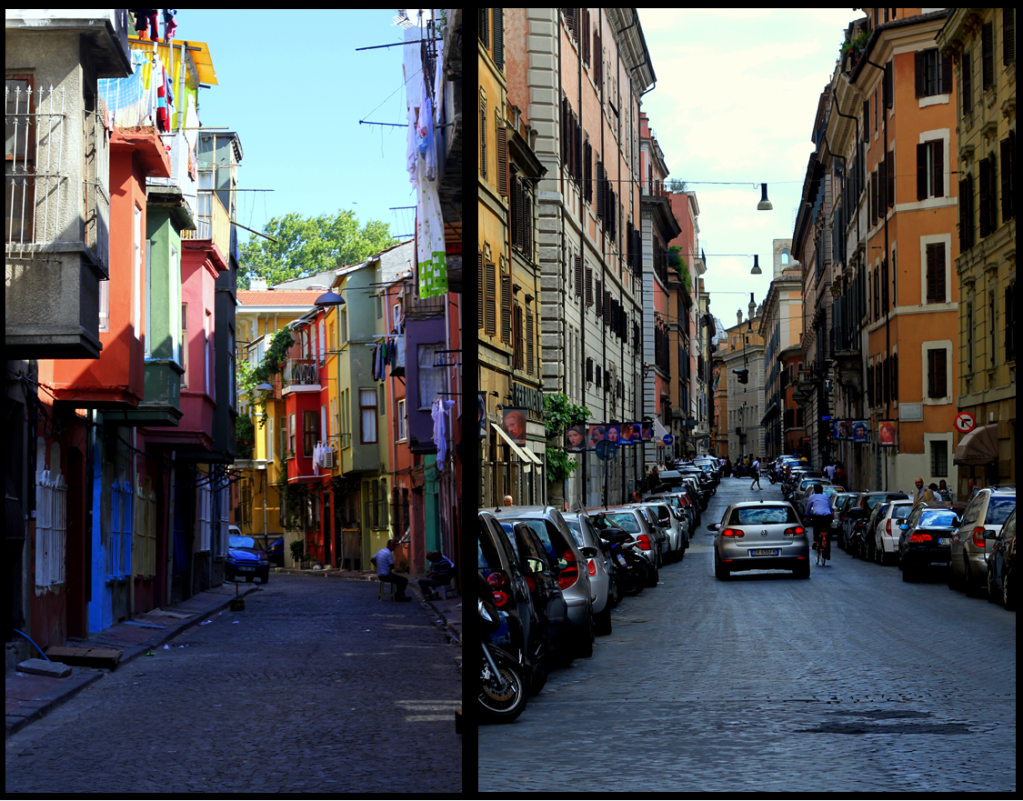
Istanbul and Rome, although linked by history, are different in many ways. However, when it comes to their residential areas, it is hard not to notice the blaring similarities. The above pictures show classic examples of typical residential neighborhoods in both Istanbul and Rome. The picture on the left is a former Jewish and Greek neighborhood in Istanbul. The picture on the right shows a larger street in the heart of Rome, close to the Ara Pacis. From a foreigner’s perspective, the resemblances between these two neighborhoods could suggest a relationship between how individuals in both cities identify their living culture.
Perhaps the most noticeable, shared feature is the variety of colors used on the building walls. Notice how the colors do not blend smoothly along the roads; instead, they define each building sharply and distinctively, causing each building to stand out. Such variety and abruptness may imply a strong sense of individualism among the people in both cities. In the Istanbul neighborhood, the color effect is more apparent. Each house possesses its own, unique shade of vibrant color, symbolizing that each family in its respective home is special and distinct. Yet Istanbul and Rome are much better known for something else: their cultural mixing. Istanbul, geographically situated between the Asian and European borders, by no surprise harbors a grand combination of cultures. Rome, with its high rate of immigration, has evolved into a multiethnic city. Thus, the potpourri of colors could represent the people identifying themselves as a potpourri of different cultures intermingling on one common ground.
Beneath the buildings, both neighborhoods share the same cobblestone roads. The presence of cobblestone, an old material for road building, portrays the enduring age of both neighborhoods. Generation after generation, these residential areas have sustained countless number of families. Thus, culture and tradition play crucial elements in everyday lives.
Although the picture of the Roman neighborhood shows a larger street, the street branches off into much smaller alleys such as the one in the Istanbul neighborhood. The streets are often very narrow, barely allowing one vehicle and maybe a few pedestrians to pass simultaneously. The small and skinny compact vehicles, shown in both pictures, reflect the narrowness of the roads. Bicycles, mopeds, motorcycles, and other small vehicles are also often seen in both cities.
Furthermore, the buildings in each picture tower over the pedestrians and cars. Almost all buildings in Rome and Istanbul are at least two or three floors high. Thus, the skinny roads and the tall buildings show how the people have accommodated to living in a large, dense population. Small residential areas contain huge communities, allowing people to communicate and sustain close relationships.
When all brought together, these comparable aspects work concurrently to create a perfect environment for a multicultural world. Such small, dense neighborhoods encourage culture crossing, and not just within the nation, but with the entire world. Yet despite the tremendous population, each person can still uphold his or her individuality and a sense of importance in society. As a foreigner looking down a common street, this is the identity that I see embraced by the people of Rome and Istanbul.
No comments:
Post a Comment